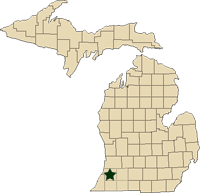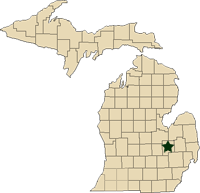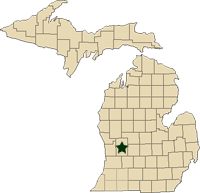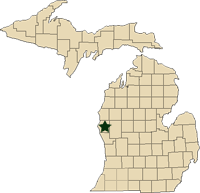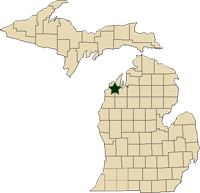Regional reports on Michigan fruit – June 21, 2011
MSU Extension educators’ pest and fruit updates for Michigan.
This week’s regional reports:
- Southwest Michigan - Mark Longstroth, Bill Shane, and Diane Brown-Rytlewski
- Southeast Michigan - Bob Tritten
- Grand Rapids Area Tree Fruit - Amy Irish-Brown and Phil Schwallier
- West Central Michigan - Mira Danilovich
- Northwest Michigan - Nikki Rothwell, Duke Elsner, and Erin Lizotte
Southwest Michigan – Mark Longstroth, Bill Shane, and Diane Brown-Rytlewski, Michigan State University Extension
|
Last week was pleasant, with highs in the 70s and 80s. Rain Wednesday (June 15) brought between an inch closer to Lake Michigan, but only about a tenth of an inch of rain further to the east. The top soil is drying out and sandy soils are very dry. Soil temperatures are in the mid-60s. We are close to normal fruit development. Check for the closest weather station at Enviro-weather.
| Southwest Michigan Growing Degree Day Totals from March 1 through June 19 | |||
| Location | GDD 42 | GDD 45 | GDD 50 |
| Bainbridge | 1251 | 1043 | 744 |
| Trevor Nichols | 1130 | 957 | 657 |
Tree fruit
San Jose scale crawlers are out. Birds are feeding on ripening cherry fruit.
Apricots are over 1.5 inches in diameter.
Peaches are about 1.25 inches in diameter. Growers are still thinning. Crop still looks good. We expect pit hardening in early varieties soon. Shoot strikes from oriental fruit moth larvae attacking shoot tips are easy to find. The larvae migrate when they get to the older woody tissue of the shoot. Oriental fruit moth trap catch is declining. Tarnished plant bug feeding is declining. Growers need to continue to protect against diseases such as peach scab, bacterial spot, and powdery mildew. Trunk sprays for borers are typically applied between now and early July.
Sweet cherries are 20 to 25 mm in diameter. Generally the fruit seems small. This may be the result of the cool spring, which could have reduced cell division during early fruit growth. Harvest of early sweet cherry varieties will begin this week with Chelan, followed by Early Star and Black Pearl. Cavalier (Rembrandt) harvest should begin by the end of the week. Birds are feeding on coloring fruit. Bird control measures need to be initiated early as the birds begin to establish the habit of feeding in the orchard. Sweet cherries become very susceptible to brown rot infection as they ripen. While cherry fruit flies have been trapped at the Trevor Nichols Research Complex near Fennville, no cherry fruit flies have been trapped in southwest Michigan cherry orchards yet.
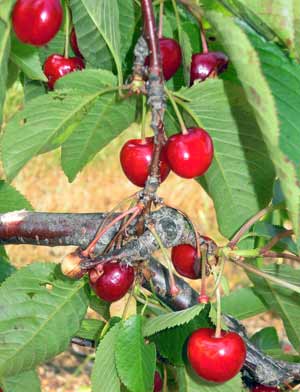
Birds feeding on sweet cherries may peck the fruit, eat part of the fruit leaving the pit or take the entire fruit leaving only the stem. Photo credit: Mark Longstroth, MSUE.
Tart cherries are about 16 to 18 mm in diameter. Cherry fruit colors during final swell and ripening. Bacterial canker symptoms can be found on both fruits and leaves. Cherry leaf spot symptoms have been found in some orchards.
Plums are an inch in diameter. For most varieties, the crop is light. Most shoot growth has stopped, so black knot control is less important. Water-soaked dark fruit spots due to bacterial spot can be found in some plantings.
Apples are over an inch in diameter. In general, the apple crop looks light. No new fire blight symptoms have been reported in the region. Primary apple scab season is over. Growers should scout for scab lesions and determine if they need to maintain protection against more scab infection. Powdery mildew is scarce even on susceptible varieties.
Codling moth trap catches are declining. Codling moth biofix was June 1 or 3. We are about 350 GDD base 50 after biofix and egg hatch is underway. Aphids and leafrollers can be found in many orchards. Obliquebanded leafroller biofix in southwest Michigan was June 13. We are about 190 GDD beyond biofix and the obliquebanded leafroller model on Enviro-weather can be used to determine the timing of controls.
Pear fruit are 1.5 inches in diameter. Pear psylla adults and nymphs can be found. First generation codling moth is generally not a concern in pears, but may be a problem in softer pear varieties. Controls should be applied in some orchards, depending on the insect population.
Small fruit
In grapes, Concord and Niagara are past berry shatter. Grape berry moth larvae are feeding on grape clusters. Grape berry moth trap catch numbers are down. Grape flea beetle larvae have been reported feeding on leaves. Grape leafhopper and potato leafhopper are out in low numbers. Post bloom sprays should focus on disease control. Most growers will be applying their first post bloom spray soon. Phomopsis symptoms are common. Black rot and downy mildew symptoms have been observed and growers should protect against all these diseases in the early post bloom sprays they will apple soon. Powdery mildew symptoms have not been observed yet.
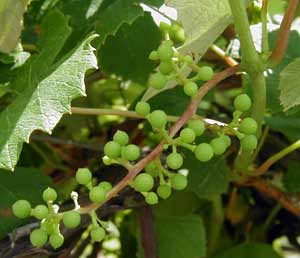
Concord grape fruit set after shatter. Photo credit: Mark Longstroth, MSUE.
Blueberry fruit are 12 mm or less in diameter Vigorous shoot growth continues in many fields. Growers need to protect against anthracnose fruit rot and fruitworms. Both cranberry fruitworm and cherry fruitworm larvae can be found in the fruit. Young blueberry plants are reported wilting and dying. Some of this is due to water stress where the hot dry weather has dried out the small peat root ball in sandy soils and the moisture in the peat is exhausted. Others were apparently killed by phomopsis infection of young basal shoots last year that moved down the shoot into the crown killing the plant this spring.
Strawberry harvest is running down. The ripening fruits have been small due to the heat in early June. Harvest should end this weekend and renovation could begin next week. Because of the wet conditions this spring, slugs are a problem in some fields.
In brambles, bloom in summer bearing raspberries is ending. Bloom in blackberries continues. Growers should be scouting for leafrollers, leaf hoppers and rose chafer. Fungicides to reduce fruit rots and cane diseases are worthwhile. Diseases noted while scouting include cane blight, spur blight and raspberry leaf spot. Primocanes in fall bearing raspberries are over two feet tall.
Cranberries are near full bloom.
Southeast Michigan – Bob Tritten, Michigan State University Extension
|
Weather
Soils remain dry across the region and are a major concern at most fruit farms, particularly on newly planted tree and small fruits and on fruit nearing harvest (strawberries and sweet cherries). Widely scattered thundershowers moved across the region late last week. Rainfall totals from these storms varied tremendously as most were narrow bands of rain. Some fortunate farms received an inch of rainfall while others did not receive any rain.
Our season continues to pick up steam in terms of degree day totals and the beginning of harvest of some of our fruit crops. I am amazed to see sweet cherries maturing so quickly, so fast that a few farms may begin sweet cherry harvest in the next three to five days. Horticulturally, it is a bit of a mystery to me how both sweet and tart cherries have picked up so much speed in terms of maturity. This is another example of how different and strange this growing season has been. Our current degree day totals are now running close to normal.
| Southeast Michigan Growing Degree Day Totals for March 1 to June 20 | |||
| Location | GDD42 | GDD45 | GDD50 |
| Commerce (Oakland) | 1199 | 1004 | 721 |
| Emmett (St Clair) | 1143 | 952 | 677 |
| Flint (Genesee) | 1230 | 1022 | 741 |
| Lapeer (Lapeer) | 1211 | 1018 | 737 |
| Petersburg (Monroe) | 1306 | 1096 | 788 |
| Pigeon (Huron) | 1039 | 857 | 598 |
| Romeo (Macomb) | 1169 | 977 | 700 |
Tree fruits
Apple drop continues across the region, although it has slowed considerably in the last week. In my report last week (June 14), I felt that fruit drop was pretty well finished, but that was not the case. I continue to see apples that have recently dropped to the orchard floor as well as other apples on the tree that the stem is turning brown, and will drop fairly soon. In the last week I have had a good opportunity to see what our apple crop looks like across the region. I would say that we have a below average crop as I look at all of the apple blocks. There is a tremendous amount of variability from farm to farm and even within block to block.
We had a tremendous bloom with three or four days of warm weather and I thought it would be a good pollinating season. As I look back at the weather that we had, directly following this period of warmth was very cold, wet and windy and I think that it washed a lot of the pollen off or it caused this fruit drop to occur. We have some farms where they had an OK to a normal crop last year that are very light this season, and we also have some farms that have not had an apple crop now for two years in a row. This is also an unusual situation that is part of an unusual season. Apples are currently at 1.25 inches in diameter for most varieties. They continue to size quite nicely.
We don’t have a tremendous amount of pest pressure in apples. Codling moth populations have been stable. Oriental fruit moth populations are low. I am seeing apple rust mite populations continue to slowly build, with overall numbers being low. There continues to be a plethora of predators at most farms, with good populations of lacewings over the last week and lady bird beetles populations continuing to build. Apple maggot traps need to be hung at this time.
I am starting to see cedar apple rust on leaves and even had some reports with some on fruit in lower fungicide managed blocks of apples. Primary apple scab ended with rainfall last Thursday, Friday and Saturday (June 16-18). While fire blight continues to be seen in blocks that have been seen for the last three weeks, I have not seen any new strikes, nor does it appear to be spreading into other blocks. Leaf symptoms from frog eye leafspot continue to show up. Powdery mildew symptoms don’t appear to be any worse at most farms.
Pears are about 1 inch in diameter. Pear psylla has new nymphs and eggs that I expect to begin hatching later in the week.
Peaches are 1.125 inches in diameter and are not at pit hardening. I continue to see a few green peach aphids and two-spotted spider mites. Bacterial spot continues to be seen and bacterial canker on wood is just beginning to show up at a few farms. Some trees have a fair amount of canker.
Sweet cherries are about 20 to 22 mm in size with a great deal of reddening. At some farms, the beginning harvest of sweet cherries is just a few days off, while others are about five to seven days away from beginning. This is actually an early harvest season for sweet cherries, which as I indicated earlier is unusual. Much of the fruit that I felt was going to drop over the last couple of weeks is now on the ground. With all the fruit drop, it appears that we have just a mediocre crop coming along this year. I am concerned about fruit size, however, as there has been very little of the normal growth or swelling as we approach harvest. I think there was a time that cell division was not adequate early in the life of our cherry crop and, regardless of how much moisture they have gotten in the last three weeks, fruit size is determined early in the season. I am seeing a few blocks where brown rot is beginning to be a problem; growers need to be on top of a final brown rot spray. I have not caught any cherry fruit fly in traps.
Tart cherries are reddening and are about 12 mm in size. I am concerned about some drop in tart cherries and size continues to be an issue.
Plums are at 22 mm in size for European plums and 1 inch in diameter for some Japanese plum varieties.
Small fruits
Strawberry harvest continues across the region. Growers in the southern part of the region are starting to see berry size diminish. I don’t see much depth to our season, and it appears that it will be a shorter than normal season. I continue to see strawberry leaf spot in many fields. This is not a concern to me at this time as the renovation process will begin soon.
Raspberry fruit continue to develop for summer fruiting types. I expect to see early harvest of black raspberries to begin in about 10 days or so. Fall red raspberries are about 30 inches or so tall. I am seeing a greater percentage than normal of the shorter canes of fall red raspberries that are developing a flower cluster at the tip of the cane. While some of these berries will be available for harvest this summer, this is quite unusual to see at such a high percentage of these canes that will be essentially a summer fruiting type as opposed to a fall bearing or fruiting type.
Blueberries are 10 to 12 mm in size with some slight signs of some blue color developing in the fruit. Blueberry maggot traps need to be hung at this time.
Grapes are nearing the end of bloom for Concord types and French hybrids are in full bloom. We have had a good amount of grape berry moth adult flight in the last week and I continue to find larvae feeding in grape clusters at several different farms.
Grand Rapids Area Tree Fruit– Amy Irish-Brown and Phil Schwallier, Michigan State University Extension
|
Tree fruit growth stages
Degree days are just a day or two above normal averages for the week of June 20, 2011. All Grand Rapids area Enviro-weather stations continue to report similar degree day numbers. The totals for the Sparta station are: 1188 base 42; 987 base 45; and 699 base 50. All apple cultivars are past the time when chemical thinners can be expected to work. Apple set is good and sized at 20 to 35 mm depending on variety and site. Growers are reporting that apple fruit set is normal to slightly over-set. June drop is starting and some growers will have to do some hand thinning of some varieties. Rains have been a little sparse in the greater Grand Rapids area, but areas to the south and north have had good rainfall totals in the past week.
Tree fruit diseases
Apple scab primary scab season is over with no new ascospores trapped in the last two rains. Growers should be carefully scouting for any primary scab that might yet show up from the infections in late May and early June. This had been a difficult year to stay ahead of apple scab. For the four weather stations in the general area, there were 17 to 19 wetting periods during primary scab season and between 7 and 13 of those were infections. The table below summarizes wetting events for apple scab in the Grand Rapids area.
| Weather Station Location | Number of Primary Scab Wetting Events | Number of Primary Apple Scab Infection Periods | Total Rainfall during Primary Scab Season |
| Sparta | 19 | 9 | 9.97 |
| Kent City | 18 | 11 | 7.75 |
| Belding | 19 | 7 | 9.65 |
| Fremont | 17 | 13 | 7.13 |
Very little fire blight is present in orchards. Growers should keep trauma blight in mind if we get storms that cause tissue damage.
Powdery mildew continues to spread in some blocks. Continue to protect new shoots and fruits until terminal bud set in susceptible varieties.
For summer diseases in apple, the model on the Enviro-Weather website indicates that we are getting close to the number of hours of wetting to initiate adding summer disease fungicides to your spray programs.
Tree fruit insects
Some new plum curculio damage is being seen in non-sprayed apples. No new stings in managed orchards have been reported in the last 7 days.
Codling moth biofix for the Grand Rapids area was set for May 30, 2011. As of midnight, June 20, we had 358 DD base 50 accumulated and it is estimated that egg hatch is at 20 percent. Cover sprays for codling moth are very important in blocks over threshold for adult male moth trap numbers.
Obliquebanded leafrollers are flying regularly. A regional biofix was set for June 14 and 149 DD base 42 have been accumulated since that date. It is estimated that early egg hatch will occur on July 1 based on this biofix and the forecasted temperatures. Growers with problem blocks should consider timing management at this earlier timing. All others can delay their first sprays by a week to 10 days or when they see 2 to 3 larvae infested terminals per tree.
European red mite can be found in all life stages. Monitor mites closely as petal fall timed miticides could start to break.
White apple leafhoppers and potato leafhoppers are now being found in all life stages. Numbers are normal to slightly above normal. Non-bearing trees have higher numbers and controls are needed to prevent shoot growth shutdown.
Dogwood borers in apples have been flying in very light numbers for the past three weeks. Trunk sprays for this pest in apples should be targeted for peak adult flight which is usually the first week of July.
West Central Michigan – Mira Danilovich, Michigan State University Extension
|
Weather
This past week the weather has been more seasonable but unstable. Three storm fronts brought significantly cooler temperatures for a day or two before going back into the 80s again. About a half inch of rain fell across the area. There are a few reports of some narrow bands of hail that inflicted some damage to the apples in Mason County. Very humid conditions have been one “constant” for the week.
Tree fruit
The crop is looking good. Pears will have a full crop. Apples are responding well to thinners across the board. Red Delicious appears to be self-thinning. Peachesare being thinned. It looks like a full crop of peaches. Tart cherries are just starting to change color. The size will improve with the most recent rains. It appears that there is 70 to 75 percent of the crop. Sweet cherries are turning red. Some of the early varieties will find their way to the market very soon.
West Central Michigan growing degree day totals since March 1 as of Sunday, June 19
| Location | DD42 | DD45 | DD50 | Rainfall | |
| Last Week | Since 4/1 | ||||
| Hart | 1039 | 856 | 596 | 0.47 | 6.82 |
| Ludington | 987 | 808 | 557 | 0.49 | 8.46 |
| Bear Lake | 1020 | 842 | 589 | 0.46 | 9.67 |
Insects
Oriental fruit moth numbers have gone down to less than one moth per trap. Redbanded leafroller numbers continue to decline. This past week we had one moth per trap in Mason County and 0.5 moths per trap in Oceana County. American plum borer numbers are declining but at a slower pace. Scouts are reporting drop from 17 moths per trap last week to 15 moths per trap this week.
Lesser peachtree borers continue with a very strong flight. The numbers are slightly down but still in double-digit numbers averaging at 10.3 per trap. The first-generation obliquebanded leafroller is emerging. Trap catches are from 1 to 2 per trap. Codling moth trap catches are significantly down averaging at 1.6 in Mason County and 3.5 in Oceana County. Sprays for the first-generation codling moth have been applied. At this point, post biofix degree-day accumulation is indicating that there is 15 to 20 percent first generation egg hatch. There are high populations of rose chafers, pear psylla and aphid complex throughout the area.
Diseases
The wetting event on June 15-17 resulted in apple scab and cherry leaf spot infections in Oceana, Mason and Manistee counties. Manistee has been under ongoing wetting events since June 19 that, as of this report, produced moderate scab and cherry leaf infection periods. Blocks that have compromised primary apple scab control and ended up with visible lesions on the leaves will need to continue with full block coverage in order to prevent lesions on the fruit. Cherry leaf spot lesions are visible in orchards throughout the area. Here too, full coverage is highly recommended. Keeping the leaf spot in check is very important since the infection leads to secondary spread and defoliation. Premature defoliation will compromise trees’ ability to mature the fruit and overall quality of the fruit. If significant leaf loss occurs before September, trees will not be prepared for the winter and will become victims of cold injury often leading to tree death. Some of the options are Pristine + Captan, Syllit + Captan, Gem, etc.
Northwest Michigan – Nikki Rothwell, Duke Elsner, and Erin Lizotte, Michigan State University Extension
|
Weather report
Temperatures have been more summerlike over the past week. However, with the warm up, we have had increased rainfall and isolated thunderstorms. Daytime temperatures over the last week were in the mid- to upper 70s, and winds were down compared to the previous week. We have accumulated 977 GDD base 42 and 541 GDD base 50; these accumulations are catching up to our 21-year average, which are 1071GDD base 42 and 602 GDD base 50. We had rainfall in the region, and it was variable by weather station. The NWMHRS received 0.20” of rainfall on June 16 and another 0.24” on June 20. More rain is forecasted for the remainder of the week. Humidity levels are extremely high at this time, and growers will be concerned about disease development under these conditions.
Crop report
The crop continues to develop here in the northwest. Cherries are sizing with the rainfall over the past week, and June drop is underway. Again, the crop size in sweet cherries is smaller than we originally estimated. The tart cherry crop is variable about the region, and the consensus is larger crop loads on younger trees while older trees have a lighter crop. The USDA crop estimate is tomorrow in Grand Rapids, and we will have a better idea of the crop for the state at that time. The apple crop is still looking very good at this time. Growers are nearing the end of the thinning window, and with the variable temperatures during the optimal thinning time, many growers are still unsure of the crop size. However, all varieties had good return bloom from our light year in 2010, and pollination was adequate.
Wild grape is in bloom, and some of the early hybrids in our variety trial are also in bloom. Vinifera vines are growing well with the adequate rainfall; growers are spraying for powdery and downy mildew, and nutrient applications are going on at this time. Rose chafers have been found in high numbers and are present in most regional vineyards.
Early strawberry harvest has begun, and the berries are sizing well, but this wet weather is a concern for the remainder of the season.
Apple pests
Based on the apple scab spore trap catch of zero during the last two rain events, and the apple scab model estimating that 100 percent of overwintering spores have matured and 97 percent have discharged, we are calling an end to primary scab in the north! We have seen leaf symptoms of scab infection in high pressure and unmanaged orchards at this time, but many area growers came through primary scab with little or no infection. As apples continue to develop, growers should continue to scout for scab lesions to help gauge the risk of fruit scab. Growers managing to protect against fruit scab should be considering second generation sterol inhibitors (Indar and Inspire Super) or Captan, all of which should be tank mixed with EBDCs; EBDCs have a 77-day PHI, so growers should be aware of their harvest dates to use these products.
At last week’s IPM Updates, growers reported the first symptoms of fire blight shoot infections. Infected shoots turn brown to black from the tip and bend near the tip to resemble a shepherd’s crook. We will be collecting fire blight samples with Dr. George Sundin on Monday, June 27, so if you have symptoms and want your orchard tested for step-resistance, please call the NWMHRS.
Spotted tentiform leafminer (STLM) trap catches were extremely low this week with just 3 per trap; larvae are present at this time and feeding on leaves and preparing to pupate. Oriental fruit moth trap emergence continued this week with 4 moths per trap. Codling moth activity continued heating up during this fifth week of emergence with an average of 7 moths per trap (a cumulative trap catch of 5 moths in one trap location warrants first generation management). Based on trap catch data from the Research Station, we set the codling moth biofix (sustained catch) at the NWMHRS as May 31 and have accumulated 283 DD50 since. The majority of treatments target egg hatch, a predicted 250 DD50 after sustained catch. Growers can track their site-specific progression using the codling moth model on Enviro-weather. Keep in mind that codling moth resistance to Guthion is well documented and that moths resistant to Guthion will also be resistant to pyrethroids. Refer to the E154 Fruit Management Guide and the codling moth model for more information on management.
Oblique-banded leafroller (OBLR) larvae (up to 1-inch in some locations but variable sizes are present) are prevalent in area apple orchards and have begun to pupate; adult moth trap catches averaging 3 moths per trap this week. Widespread OBLR resistance to Guthion and pyrethroids exists in northwest Michigan, so growers should NOT be applying organophosphate materials or pyrethroids to control this insect this season. Growers can scout for multiple life stages of OBLR; adults moths are easily trapped with pheromone-baited delta traps, and larvae are also relatively easy to locate due to their leaf-rolling behavior. Reports of plum curculio egg laying scars in apple have been reported. Lacewing adults have also been observed this week--lacewing larvae are beneficial predators.
Cherry pests
Oblique-banded leafroller (OBLR) activity continues, and larvae, pupae and adults are present in area orchards. Targeting the overwintering generation is preferable in cherry and more effective when larvae are small and easier to kill. Based on scouting, the ideal window for first generation OBLR management at the Research station has closed with large larvae, pupae, and adult moths present at this time. For growers that were not able to make an application targeting overwintering larvae, a second management window will be available at harvest.
Green fruitworm larvae are also present (1-inch when observed this week) and feeding damage to fruit is browning and relatively easy to spot.Plum curculio activity is evident in area orchards with crescent shaped egg laying scars easily visible on green fruit and some infested fruit beginning to drop from the trees. If growers are utilizing insecticides other than the organophosphates (Guthion, Imidan), the traditional treatment timing is petal fall or shuck split depending on the mode of action. Consult the insecticide label and the MSU Extension Bulletin E154 “Michigan Fruit Management Guide” for more information on proper timing. Based on a full bloom biofix of 21 May in Montmorency, we have accumulated 380 DD50 towards the ideal 375 DD50 window for organophosphate application for plum curculio management, making this the critical time for management at the Research Station. Growers can track their own progress on farm using the plum curculio model.
First generation American plum borer emergence continues at low levels, a second generation emergence is expected around tart cherry harvest. Lesser peach tree borer (LPTB) was caught in Station traps for the third week in a row with an average of 2 moths per trap. Based on historical trap catch data, we would expect peak trap catches to reach closer to 20+ moths per trap and will reserve trunk sprays for that time. LPTB produce one generation per season with treatment targeting adult flight. No peach tree borer has been trapped.
The potential for epidemic levels of cherry leaf spot (CLS) is a concern this season. Despite some relatively tame leaf spot weather and model predictions as well as standard management practices, symptoms have been present since late May. Growers are reminded that CLS is resistant to sterol inhibitor fungicides (Indar, Elite, Orbit) in all the major fruit producing areas of Michigan. As growers apply cover sprays, they should remember to alternate the use of fungicide classes and tank mix dodine and strobilurin fungicides with a full rate of Captan to manage against resistance development. Under cool conditions, copper is an excellent CLS material and a good strategy for resistance management; copper applications needs to be at 1.2lb metallic copper. Lime is also recommended as a safener, but Imidan cannot be used in this tank mix due to pH. Spur death caused by European brown rot and bacterial canker has been reported and is easily visible around the region as tissue turns brown. Canker symptoms are also present on sweet cherry leaves—particularly in areas with leaf damage caused by high winds. Unfortunately, no control options will work against bacterial canker or European brown rot at this time.
Lastly, green lacewing adults are out in large numbers this week, the larvae of lacewings are beneficial predators.
Wine grape pests
Bloom is fast approaching in NW Michigan. Foliage condition still looks great for the most part.
Rainy weather in recent days has created a greater than normal chance for downy mildew to be an issue this year. This is not a common disease in our area, but we should not ignore looking for it. Powdery mildew still has not appeared at our scouted locations. Injury symptoms from potato leafhopper feeding has appeared on many cultivars over the last week. The populations of adult rose chafers are fairly high this year, resulting in both foliar and flower bud feeding injury.
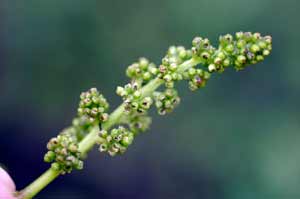
Rose chafer on flower buds.
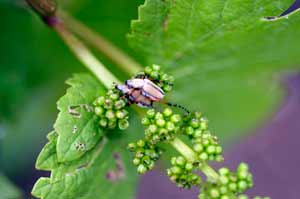
Rose chafer on flower buds.
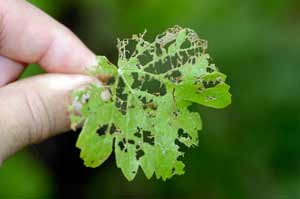
Rose chafer injury to leaves.
Saskatoons
The fruit of earlier varieties is starting to color. Fruit injured by insects sometimes colors rapidly, so inspect any fruit clusters that seem to have some fruits that are way ahead. Entomosporium leaf and berry spot, an important fungal disease, was quite prevalent in some nursery beds last week. This should be less of a problem in field settings where there is greater air circulation and faster drying of foliage. If rainy conditions persist, this could be a big problem over the rest of the season. Rose chafers have been a huge problem in some fields, especially in Benzie and Manistee Counties.



 Print
Print Email
Email